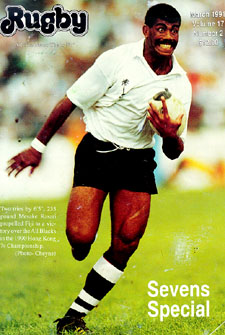 |
||
 |
||

Introduction
It is considered opinion of many in the U.S. that sevens is the ideal vehicle with which to introduce the game to America's finest athlete's and its millions of action-hungry sport fans. The purpose of this text therefore, is to provide the rugby public with an in-depth analysis of sevens so that may intellingently spread the word.
I love fifteens, and I have coached it far more frequently and with just as much enjoyment as sevens. But, with rare exceptions, it's not much of a spectators' game: unless you're really a connoisseur of rugby, the majority of fifteens' games can appea complicated and slow with too much kicking. And, for the new Bo Jackson that we've dragged out to star for our team, 80 minutes on the wing without seeing the ball can result in a rapid loss of interest.
Sevens, however, is a wide-open game with fourteen fit, fast players covering more than 2 acres of ground. Statistics show that an average of five tries are scored in a 14-minute game. A contact sport with scores every three minutes can excite anyone fascinated by speed and competitiveness.
And what better way to get the sporting public involved than by televising sevens?. In a 90-minute show, we could see the championship match, preceded by the finalists' semi- and quarter-final matches, probably including more than 25 tries.
To get a new level of athlete attracted to rugby, why not provide that athlete with a game in which outstanding talent is showcased?. That new Bo Jackson will certainly not die of boredom in a sevens match -- if his team is winning the ball, he'll be scoring tries; if not, he'll be making lots of try-saving tackles.
There are legitimate reasons, for the dedication of so much of my time during the last five years to put together this publication. And there must also be compelling reasons why Rugby Magazine is dedicating an entire issue to sevens.
One is a response to numerous requests by players and coaches for an in-depth text to help them learn about the game and play it better. And the second is that by promoting sevens we are promoting rugby. By providing and environment in which good athletes can quickly showcase their talents, we improve the possibility of getting these athletes to play fifteen-a-side rugby.
Background
My first exposure to sevens was as a hooker/prop at the 1969 Whitemarsh Sevens. Since then I have seen American sevens grow from a curiosity played at a handful of tournaments to a serious sport played throughout the summer by a large number of clubs and players dedicated to both team and individual achievement.
Currently there are more than 80 documented sevens tournaments in the US; given those whose existence has not yet been discovered by Rugby, the actual number probably is closer to 100.
Recognizing the de facto status of sevens as a summer-long phenomenon, the USARFU has declared an official 12-week sevens season, beginning with the first Saturday in June.
Sevens is taken seriously in many places throughout the world. These include the Scottish Borders where it originated; London where it annually fills rugby's "HQ," Twickenham; Hong Kong where the greatest rugby event of each year takes place; Fiji, where 20,000 people crowded the streets to greet the 1990 world champions; Australia and New Zealand, where they try to dominate the sevens world as fervently as the fifteens;
Sources
The scope of this publication is broader than that any type of any previous text on the subject, as it attempts to present a world view of sevens from both historical and technical points of view. The information contained herein draws on three major sources:
- My own research and 15 years of coaching and viewing sevens at both domestic and the international stage
- Two excellent books, Mike William's Rugby Sevens (1975) and Chris Bass Seven-a-side rugby (1981). Both unfortunately, are now out of print, and
- Views of the top coaches, players and administratorss from around the world.
These include but are not limited to:
Scotland:
Jim Telfer. A product of Melrose, the home of sevens, Jim Telfer has coached not only Melrose but also Scotland and the British Lions.
Jim Hewitt. A member of the 1978 Kelso team that began their sevens "dynasty," Hewitt has been the Kelso coach for the past several years.
England:
Dick Best. Best coached the Harlequins side throughout the 1980s, during which time it became the first side ever to win five consecutive Middlesex championships (1986-90). The current England "B" coach.
New Zealand:
Bill Freeman. Bill was the Technical Director of the New Zealand RFU during the mid-1980s, the time in which it rose from mediocrity in sevens to the same level it has always enjoyed in fifteens: world champion.
Bryce Rope. Coach to New Zealand during the same time frame that Freeman was its Technical Director, Rope led New Zealand to its famous triple sevens championships in 1986: at Sydney, Hong Kong and Cardiff.
Peter Thorburn. Rope's successor, he led the All-Blacks to victories at Sydney in 1988 and both Sydney and Hong Kong in 1989.
Australia:
Bob Dwyer. The Australian national coach through much of the last ten years, including two great victories over New Zealand: at Hong Kong in 1988, and in their great fifteens' upset in 1990.
John Maxwell. The player/coach of the Randwick team that walked away with the 1990 Melrose championship, Maxwell played for Australia at six Hong Kong sevens, captained them during that time period, and was a member of three Hong Kong champions.
Fiji:
Kitione Tuibua. A first year national coach in 1990, Tuibua led Fiji back to the world championship status it had not enjoyed since 1984.
Hong Kong:
Jim Rowark. Architect of Hong Kong's rise through the sevens ranks: to the Cup round in 1989, and to a near-upset of Wales and a Plate Championship in 1990.
United States:
Charlie Wilkinson. A sevens Eagle since 1985, Charlie is not only one of the best, but also one of the most knowledgeable sevens players in the US.
Copyright 1999-2024
